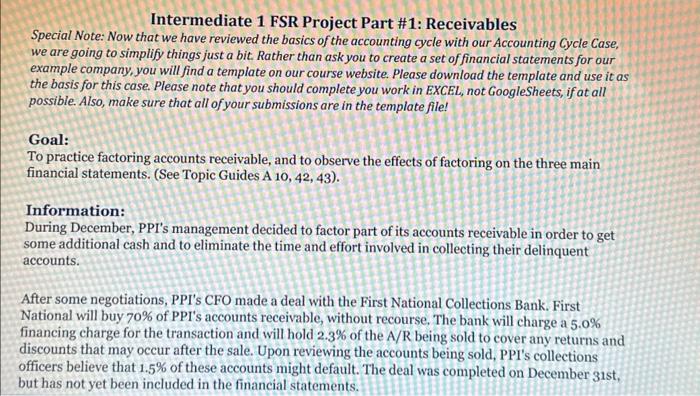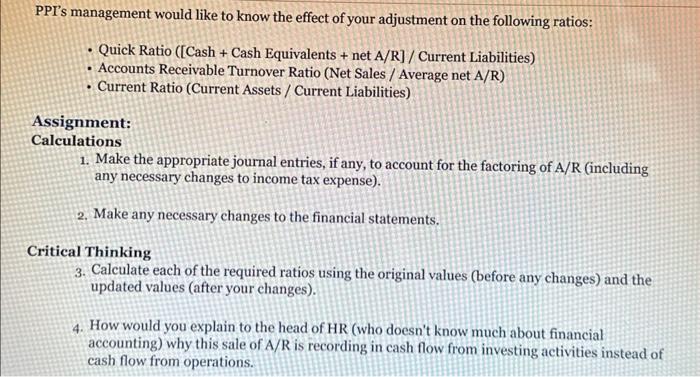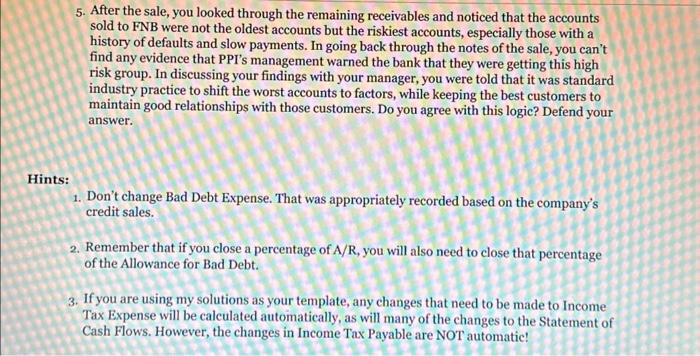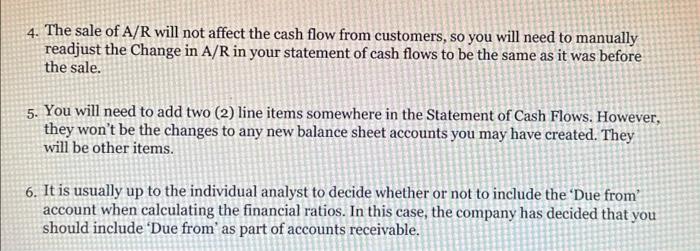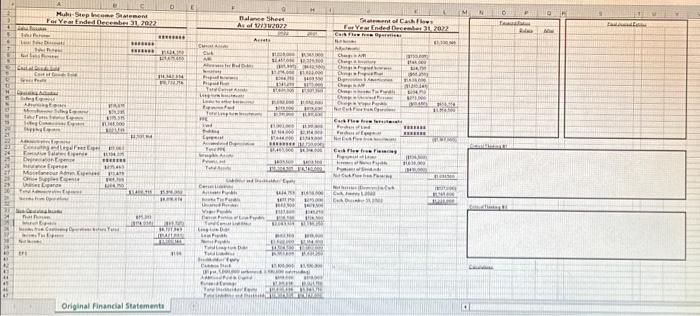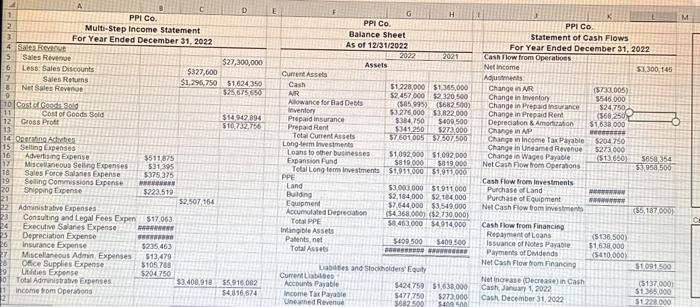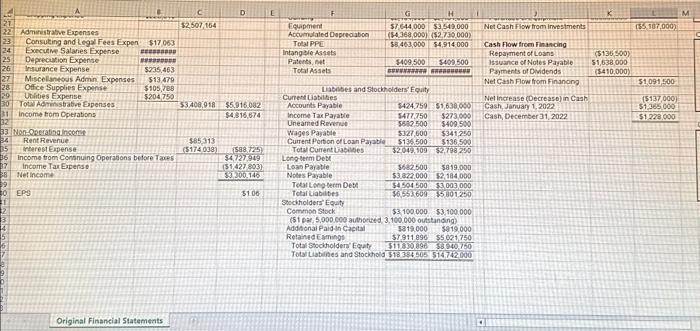Intermediate 1 FSR Project Part \#1: Receivables Special Note: Now that we have reviewed the basics of the accounting cycle with our Accounting Cycle Case, we are going to simplify things just a bit. Rather than ask you to create a set of financial statements for our example company, you will find a template on our course website. Please download the template and use it as the basis for this case. Please note that you should complete you work in EXCEL, not GoogleSheets, if at all possible. Also, make sure that all of your submissions are in the template file! Goal: To practice factoring accounts receivable, and to observe the effects of factoring on the three main financial statements. (See Topic Guides A 10, 42, 43). Information: During December, PPI's management decided to factor part of its accounts receivable in order to get some additional cash and to eliminate the time and effort involved in collecting their delinquent accounts. After some negotiations, PPI's CFO made a deal with the First National Collections Bank. First National will buy 70% of PPI's accounts receivable, without recourse. The bank will charge a 5.0% financing charge for the transaction and will hold 2.3% of the A/R being sold to cover any returns and discounts that may occur after the sale. Upon reviewing the accounts being sold, PPI's collections officers believe that 1.5% of these accounts might default. The deal was completed on December 31st, but has not yet been included in the financial statements. PPI's management would like to know the effect of your adjustment on the following ratios: - Quick Ratio ([Cash + Cash Equivalents + net A/R] / Current Liabilities) - Accounts Receivable Turnover Ratio (Net Sales / Average net A/R) - Current Ratio (Current Assets / Current Liabilities) Assignment: Calculations 1. Make the appropriate journal entries, if any, to account for the factoring of A/R (including any necessary changes to income tax expense). 2. Make any necessary changes to the financial statements. Critical Thinking 3. Calculate each of the required ratios using the original values (before any changes) and the updated values (after your changes). 4. How would you explain to the head of HR (who doesn't know much about financial accounting) why this sale of A/R is recording in cash flow from investing activities instead of cash flow from operations. 5. After the sale, you looked through the remaining receivables and noticed that the accounts sold to FNB were not the oldest accounts but the riskiest accounts, especially those with a history of defaults and slow payments. In going back through the notes of the sale, you can't find any evidence that PPI's management warned the bank that they were getting this high risk group. In discussing your findings with your manager, you were told that it was standard industry practice to shift the worst accounts to factors, while keeping the best customers to maintain good relationships with those customers. Do you agree with this logic? Defend your answer. 1. Don't change Bad Debt Expense. That was appropriately recorded based on the company's credit sales. 2. Remember that if you close a percentage of A/R, you will also need to close that percentage of the Allowance for Bad Debt. 4. The sale of A/R will not affect the cash flow from customers, so you will need to manually readjust the Change in A/R in your statement of cash flows to be the same as it was before the sale. 5. You will need to add two (2) line items somewhere in the Statement of Cash Flows. However, they won't be the changes to any new balance sheet accounts you may have created. They will be other items. 5. It is usually up to the individual analyst to decide whether or not to include the 'Due from' account when calculating the financial ratios. In this case, the company has decided that you should include 'Due from' as part of accounts receivable. Original Financial Statements Intermediate 1 FSR Project Part \#1: Receivables Special Note: Now that we have reviewed the basics of the accounting cycle with our Accounting Cycle Case, we are going to simplify things just a bit. Rather than ask you to create a set of financial statements for our example company, you will find a template on our course website. Please download the template and use it as the basis for this case. Please note that you should complete you work in EXCEL, not GoogleSheets, if at all possible. Also, make sure that all of your submissions are in the template file! Goal: To practice factoring accounts receivable, and to observe the effects of factoring on the three main financial statements. (See Topic Guides A 10, 42, 43). Information: During December, PPI's management decided to factor part of its accounts receivable in order to get some additional cash and to eliminate the time and effort involved in collecting their delinquent accounts. After some negotiations, PPI's CFO made a deal with the First National Collections Bank. First National will buy 70% of PPI's accounts receivable, without recourse. The bank will charge a 5.0% financing charge for the transaction and will hold 2.3% of the A/R being sold to cover any returns and discounts that may occur after the sale. Upon reviewing the accounts being sold, PPI's collections officers believe that 1.5% of these accounts might default. The deal was completed on December 31st, but has not yet been included in the financial statements. PPI's management would like to know the effect of your adjustment on the following ratios: - Quick Ratio ([Cash + Cash Equivalents + net A/R] / Current Liabilities) - Accounts Receivable Turnover Ratio (Net Sales / Average net A/R) - Current Ratio (Current Assets / Current Liabilities) Assignment: Calculations 1. Make the appropriate journal entries, if any, to account for the factoring of A/R (including any necessary changes to income tax expense). 2. Make any necessary changes to the financial statements. Critical Thinking 3. Calculate each of the required ratios using the original values (before any changes) and the updated values (after your changes). 4. How would you explain to the head of HR (who doesn't know much about financial accounting) why this sale of A/R is recording in cash flow from investing activities instead of cash flow from operations. 5. After the sale, you looked through the remaining receivables and noticed that the accounts sold to FNB were not the oldest accounts but the riskiest accounts, especially those with a history of defaults and slow payments. In going back through the notes of the sale, you can't find any evidence that PPI's management warned the bank that they were getting this high risk group. In discussing your findings with your manager, you were told that it was standard industry practice to shift the worst accounts to factors, while keeping the best customers to maintain good relationships with those customers. Do you agree with this logic? Defend your answer. 1. Don't change Bad Debt Expense. That was appropriately recorded based on the company's credit sales. 2. Remember that if you close a percentage of A/R, you will also need to close that percentage of the Allowance for Bad Debt. 4. The sale of A/R will not affect the cash flow from customers, so you will need to manually readjust the Change in A/R in your statement of cash flows to be the same as it was before the sale. 5. You will need to add two (2) line items somewhere in the Statement of Cash Flows. However, they won't be the changes to any new balance sheet accounts you may have created. They will be other items. 5. It is usually up to the individual analyst to decide whether or not to include the 'Due from' account when calculating the financial ratios. In this case, the company has decided that you should include 'Due from' as part of accounts receivable. Original Financial Statements
